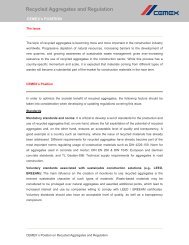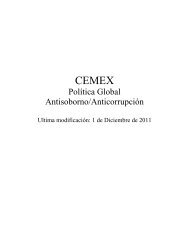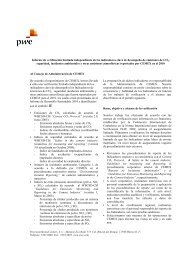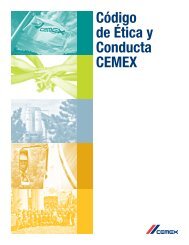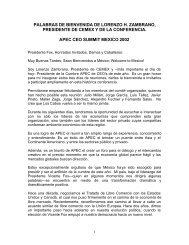building a STRONGER foundation - Cemex
building a STRONGER foundation - Cemex
building a STRONGER foundation - Cemex
Create successful ePaper yourself
Turn your PDF publications into a flip-book with our unique Google optimized e-Paper software.
In the U.S., the recession was longer and deeper than the previous two recessions during the 1990s and in early 2000, and the<br />
economy continues to languish. In December 2010, housing starts, the primary driver of cement demand in the residential sector,<br />
reached an annual rate of 586,900, according to the U.S. Census Bureau, which was less than 10% higher than the annual rate of<br />
554,000 in 2009. The timing of a housing recovery remains uncertain given the current market environment, tight credit conditions<br />
and housing oversupply. As part of the announced government fiscal stimulus package, the U.S. Congress passed the American<br />
Recovery and Reinvestment Act of 2009, which provides approximately U.S.$85 billion for infrastructure spending. To date, however,<br />
spending under this program has not been entirely effective to offset the decline in cement and ready-mix concrete demand as a result<br />
of current economic conditions. The uncertain economic environment and tight credit conditions also adversely affected the U.S.<br />
industrial and commercial sectors during 2010, with contract awards — a leading indicator of construction activity — declining 17%<br />
in 2010 compared to 2009, according to FW Dodge. This combination of factors resulted in the worst decline in sales volumes that we<br />
have experienced in the United States in recent history. Our U.S. operations’ domestic cement sales volumes were flat and ready-mix<br />
concrete sales volumes decreased approximately 7% in 2010 compared to 2009.<br />
The Mexican economy has also been significantly and adversely affected by the financial crisis. Mexican dependence on the<br />
U.S. economy remains very important, and therefore, any downside to the economic outlook in the United States may hinder the<br />
recovery in Mexico. The crisis has also adversely affected local credit markets resulting in an increased cost of capital that may<br />
negatively impact companies’ ability to meet their financial needs. During 2008, the Mexican Peso depreciated by 26% against the<br />
Dollar. During 2009 and 2010, the Mexican Peso had a mild recovery, appreciating by approximately 5% and 6%, respectively,<br />
against the Dollar. Exchange rate depreciation and/or volatility in the markets would adversely affect our operational and financial<br />
results. We cannot be certain that a contraction of Mexican economic output will not take place, which would translate into a more<br />
challenging outlook for the construction sector and its impact on cement and concrete consumption. According to the Mexican<br />
Statistics Office (Instituto Nacional de Estadística, Geografía e Informática, or “INEGI”), spending on infrastructure-related projects<br />
increased approximately 1% for the full year 2010 compared to 2009, and approximately 15% for the full year 2009 compared to<br />
2008. However, we cannot give any assurances that this trend will continue, as the Mexican government’s plan to increase<br />
infrastructure spending could prove to be, as in other countries, difficult to implement in a timely manner and in the officially<br />
announced amounts. As a result of the current economic environment, our domestic cement and ready-mix concrete sales volumes in<br />
Mexico decreased approximately 4% in 2010 compared to 2009.<br />
Many Western European countries, including the U.K., France, Spain, Germany and Ireland, have faced difficult economic<br />
environments due to the financial crisis and its impact on their economies, including the construction sectors. If this situation were to<br />
deteriorate further, our financial condition and results of operations could be further affected. The situation has been more pronounced<br />
in those countries with a higher degree of previous market distortions (especially those experiencing real estate bubbles and durable<br />
goods overhangs prior to the crisis), such as Spain, or those more exposed to financial turmoil, such as the U.K. According to<br />
OFICEMEN, the Spanish cement trade organization, domestic cement demand in Spain declined 15% in 2010 compared to 2009. Our<br />
domestic cement and ready-mix concrete sales volumes in Spain decreased approximately 22% and 20%, respectively, in 2010<br />
compared to 2009. In the U.K., according to the British Cement Association, domestic cement demand increased approximately 3% in<br />
2010 compared to 2009. Our domestic cement sales volumes in the U.K. increased approximately 1%, while the ready-mix concrete<br />
sales volumes in the U.K. decreased approximately 3% in 2010 compared to 2009. In the construction sector, the residential<br />
adjustment could last longer than anticipated, while non-residential construction could experience a sharper decline than expected.<br />
Finally, the boost to infrastructure spending that is anticipated as a result of the stimulus packages that have been announced by most<br />
European countries could be lower than projected due to bureaucratic hurdles, delays in implementation or funding problems. If these<br />
risks materialize, our business, financial condition, and results of operations may be adversely affected. The important trade links with<br />
Western Europe make some of the Eastern European countries susceptible to the Western European recession. Large financing needs<br />
in these countries pose a significant vulnerability. Central European economies could face delays in implementation of European<br />
Union Structural Funds (funds provided by the European Union to member states with lowest national incomes per capita) related<br />
projects due to logistical and funding problems, which could have a material adverse effect on cement and/or ready-mix concrete<br />
demand. In addition, the current concerns about sovereign debt and the budget deficit levels of Greece, Ireland, Portugal, Spain and<br />
several other European Union countries have resulted in increased volatility and risk perception in the financial markets. The plan<br />
announced in May 2010 by the European Union and the International Monetary Fund to provide approximately €720 billion to support<br />
financial stability in Europe is designed to reduce liquidity risk and debt default probability of any individual European Union<br />
member. However, under these and similar plans, fiscal adjustments would need to be implemented in countries with unsustainable<br />
fiscal deficits, which likely will lead to a decrease in infrastructure investment in some countries, including Spain, which could have a<br />
material adverse effect on cement and/or ready-mix concrete demand and/or would delay any expected economic recovery.<br />
The Central and South American economies also pose a downside risk in terms of overall activity. The financial downturn,<br />
lower exports to the U.S. and Europe, lower remittances and lower commodity prices could represent an important risk for the region<br />
in the short term. This may translate into greater economic and financial volatility and lower growth rates, which could have a material<br />
adverse effect on cement and ready-mix concrete consumption and/ or prices. Political or economic volatility in the South American,<br />
Central American or the Caribbean countries in which we have operations may also have an impact on cement prices and demand for<br />
cement and ready-mix concrete, which could adversely affect our business and results of operations.<br />
5



